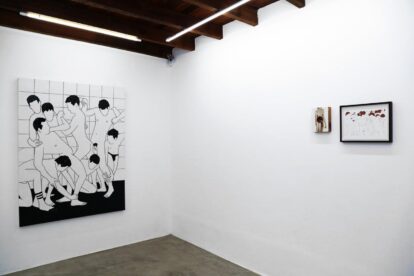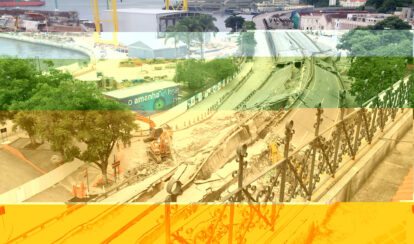Francisco Hurtz has the gift of grace, which is a delicate form of beauty. He claims the title of queer artist, which he is. Its themes are exclusively centered on the universe of homosexual pleasures and obsessions. He is not the only one to do this, quite the opposite: contemporary art is very rich in artists and productions in the same field. What makes Francisco Hurz original is not this universe from which he draws his creative impulses. It is the fact that the results are manifested through an innocent grace, which takes away all weight and all sin from their works.
This makes them go far beyond the ghetto. Alair Gomes’s photos seduce not for their erotic direction – or, at least, not only – but for the extraordinary beauty that emanates from them. They possess the splendor of bodies created by rebirth. Those that show an immediate sexual appeal are very rare. The works of Francisco Hurtz, on the other hand, do not exert this kind of attraction either. They are refined and subtle, from the drawings to the photos.
His drawings depict faceless young people. The line is very thin. It finds its greatest immaterial substance when engraved on metallic plates. Immateriality is persistent and remains when traced on paper, because the figures remain transparent, without modeling and because the risk is precise and constant. Its young people, represented in this way, resemble the schematic figures that illustrate certain physical education manuals. They are distinguished from them, however, by their graphic beauty.
Francisco Hurtz’s most incisive force is his graphics. His drawings have something of a writing and they work like signs. The characters he creates close themselves in an intimate life, indifferent to the spectator, existing fully in the light of the abstract background. The erotic relationships they maintain with each other, or the pure presence, when they are alone, lead to a contemplation from the outside, to a distant vision: we discover the pleasure of beings that enchant us and in which we do not participate.
I try to explain by comparing. Tom of Finland left images revered by gays who are interested in art or not. His creations are intended for strong sensual stimuli, implying the rude frankness of the sexual act, to be read in the left hand. This is by no means the case with Francisco Hurtz’s drawings that live in the world of emblems. Due to the graphic debugging and the sensitive quality of the situations represented, it is not surprising that they are as successful as identifying tattoos around the world.
The works in which Francisco Hurtz uses colors, on paper or canvas, demonstrate the same linear statement and are simplified by monochromatism. They embody, once again, something demonstrative: their aspect immediately stands out as intellectual. We went from physical education manuals to old home medicine books. But this allusion that I make here does not go far, because they are works that are far above a reference of this kind thanks to the internal and indifferent life that is proper to them. As if to say, with instating power, “this exists and this is how it is”.
From the photographer Francisco Hurtz almost always emanates an anti-eroticism through this always constant indicator and demonstrative character. The photos are also born from an intellectual game, which the manipulations carried out on the images, when they exist, confirm.
These permanent elements guarantee the originality so evident and so recognizable in what Francisco Hurtz creates. It is not a question of a sought-after originality, which would therefore be artificial or strategic. It springs up just like itself, owing nothing to anyone. Each of his drawings, watercolors, paintings or photos enchants and seduces beyond the militancy and erotic impulses of each one.



![Com o rabo entre as pernas [With the tail between the legs]](https://www.vervegaleria.com/wp-content/uploads/2022/06/com_o_rabo_entre_as_pernas_2017-2019-768x1061.jpg)
![Retrato AGLC [Portrait of AGLC]](https://www.vervegaleria.com/wp-content/uploads/2022/06/retrato_AGLC_2017-768x1387.jpg)

![Orientar-se [Orient yourself]](https://www.vervegaleria.com/wp-content/uploads/2022/06/orientar-se_2020low-768x1052.jpg)
![A colonização grega [The Greek colonization]](https://www.vervegaleria.com/wp-content/uploads/2022/06/a_colonizacao_grega_2020low-768x559.jpg)
![Violência e carnaval (1969-2019) [Violence and carnival (1969-2019)]](https://www.vervegaleria.com/wp-content/uploads/2022/06/violencia_e_carnaval_2019-768x1152.jpg)
![Fim de tarde [Late afternoon]](https://www.vervegaleria.com/wp-content/uploads/2022/06/fim_de_tarde_2019-768x954.jpg)
![Três graças [Three graces]](https://www.vervegaleria.com/wp-content/uploads/2022/06/tres_gracas-2019-768x1076.jpg)
![Dispneia [Dyspnea]](https://www.vervegaleria.com/wp-content/uploads/2022/06/dispneia_2021-768x1022.jpg)
![Fratura [Fracture]](https://www.vervegaleria.com/wp-content/uploads/2022/06/fratura_insta2022-768x910.jpg)
![Tortura I [Torture I]](https://www.vervegaleria.com/wp-content/uploads/2022/06/tortura1-768x1079.jpg)
![Tortura V [Torture V]](https://www.vervegaleria.com/wp-content/uploads/2022/06/tortura5_2017-768x1073.jpg)


![Capitalistas [Capitalists]](https://www.vervegaleria.com/wp-content/uploads/2022/06/capitalistas_2019-768x555.jpg)
![Oficiais IV [Officers IV]](https://www.vervegaleria.com/wp-content/uploads/2022/06/oficiais4_2013-768x546.jpg)

![Eu e os outros I, II & III [Me and the others I, II & III]](https://www.vervegaleria.com/wp-content/uploads/2022/06/FH_Eu-e-os-outros-I-II-III.jpg)
![Mandamento [Commandment]](https://www.vervegaleria.com/wp-content/uploads/2022/06/pinturaempedra-768x984.jpg)

![Nadadores [Swimmers]](https://www.vervegaleria.com/wp-content/uploads/2022/06/FH_Nadadores-768x440.jpg)
![Janela [Window]](https://www.vervegaleria.com/wp-content/uploads/2022/06/fotoo-768x543.jpg)

![Metáfora para o medo [Metaphor for fear]](https://www.vervegaleria.com/wp-content/uploads/2022/06/FH_Metafora-para-o-medo-768x1024.jpg)

![Mentira [Lie]](https://www.vervegaleria.com/wp-content/uploads/2022/06/mentira-768x877.jpg)
![Os insuportáveis [The unbearables]](https://www.vervegaleria.com/wp-content/uploads/2022/06/insuportaveis-768x1039.jpg)
![Nadadores [Swimmers]](https://www.vervegaleria.com/wp-content/uploads/2022/06/escada-768x1088.jpg)
![Halterofilista [Weightlifter]](https://www.vervegaleria.com/wp-content/uploads/2022/06/siteeeee-768x1030.jpg)














